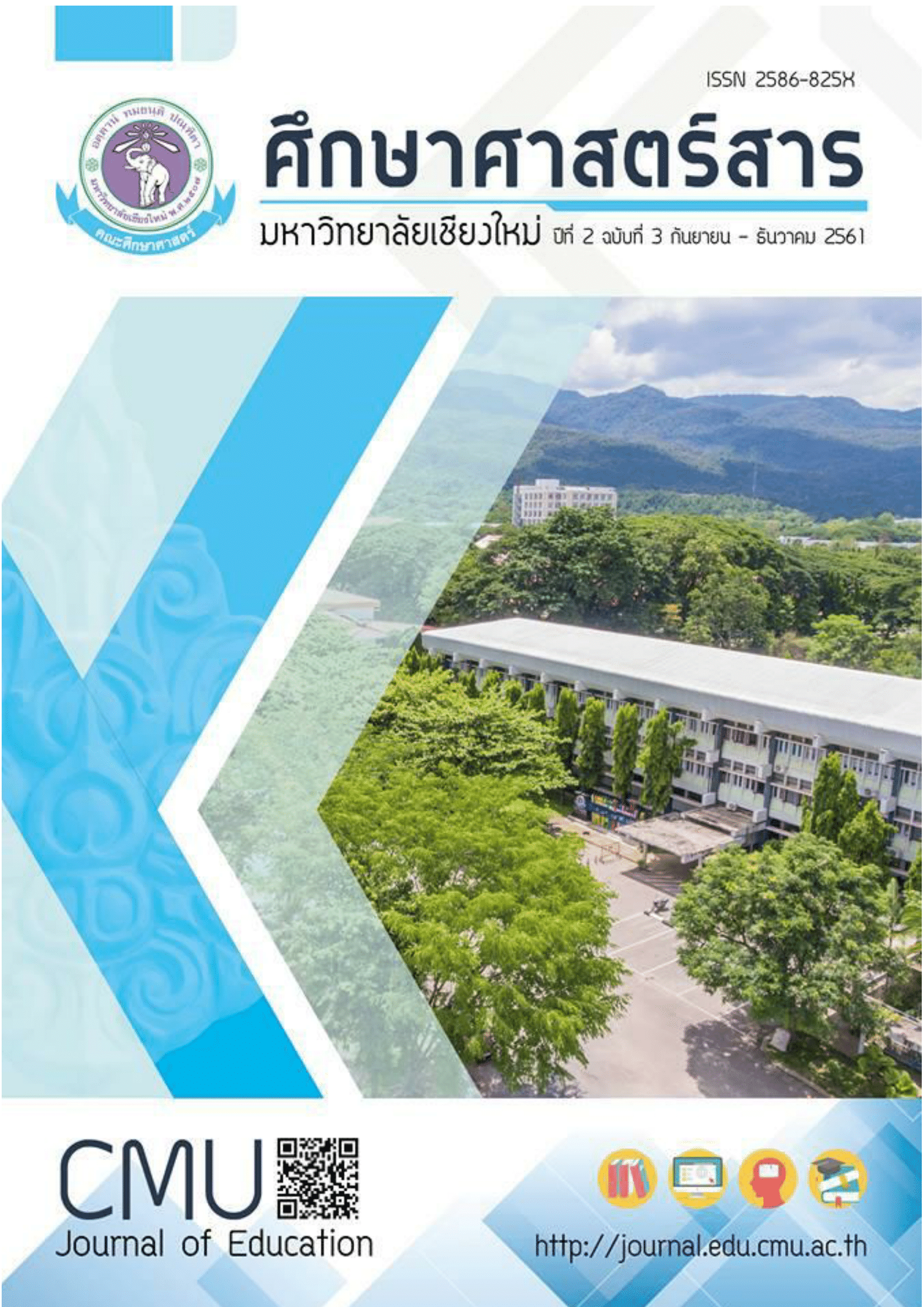ปัจจัยที่มีอิทธิพลต่อการสอนสัมมนาการบริหารงานตำรวจของโรงเรียนนายร้อยตำรวจ
Main Article Content
บทคัดย่อ
การวิจัยมีวัตถุประสงค์เพื่อศึกษา (1) คุณลักษณะทั่วไปของคุณลักษณะผู้สอน สถานที่ใช้สอน เทคนิคการสอน สื่อการสอน เกรดและความพอใจที่ได้รับ และ (2) อิทธิพลทางตรง ทางอ้อม และผลรวมของสถานที่ใช้สอน เทคนิคการสอนและสื่อการสอนที่มีต่อการสอนวิชาสัมมนาการบริหารงานตำรวจ ใช้ระเบียบวิธีการวิจัยทั้งเชิงปริมาณและเชิงคุณภาพ เชิงปริมาณใช้แบบสอบถามเก็บข้อมูลจากนักเรียนนายร้อยตำรวจ 86 ราย วิเคราะห์ข้อมูลด้วยสถิติพรรณนาและเทคนิคการวิเคราะห์เส้น ทาง เชิงคุณภาพเก็บข้อมูลจากสัมภาษณ์เจาะลึก สนทากลุ่ม สังเกตแบบไม่มีโครงสร้าง และบันทึกความจำจากนักเรียนนายร้อยตำรวจจำนวน 18 ราย ผลการวิจัยพบว่า (1) นักเรียนนายร้อยตำรวจส่วนใหญ่คิดเห็นว่าวิชาสัมมนาการบริหารงานตำรวจใช้สถานที่ห้องเรียนประจำเป็นที่เรียน ผู้สอนส่วนใหญ่เป็นอาจารย์ประจำเพศชาย อายุไม่เกิน 50 ปี ใช้เทคนิคกระบวนการสืบ สวนสอบสวนในการสอนและใช้สื่อประเภทวิธีการ ซึ่งนักเรียนนายร้อยตำรวจพึงพอใจค่อนข้างมากต่อการสอนของผู้สอน ผลการเรียนปีการศึกษา 2560 ส่วนใหญ่ได้เกรดบีบวก และ (2) เทคนิคการสอนมีอิทธิพลทางตรงต่อการสอนสัมมนาการบริหาร งานตำรวจมากสุด ขณะที่สถานที่ใช้สอนมีอิทธิพลทางอ้อมและผลรวมต่อการสอนวิชาสัมมนาการบริหารงานตำรวจมากที่สุด
Article Details
หากผู้เสนอบทความมีความจำเป็นเร่งด่วนในการตีพิมพ์โปรดส่งลงตีพิมพ์ในวารสารฉบับอื่นแทน โดยกองบรรณาธิการจะไม่รับบทความหากผู้เสนอบทความไม่ปฏิบัติตามเงื่อนไขและขั้นตอนที่กำหนดอย่างเคร่งครัด ข้อมูลของเนื้อหาในบทความถือเป็นลิขสิทธิ์ของ Journal of Inclusive and Innovative Education คณะศึกษาศาสตร์ มหาวิทยาลัยเชียงใหม่
เอกสารอ้างอิง
กรรณิการ์ สุขเกษม และสุชาติ ประสิทธิ์รัฐสินธุ์. (2558). คู่มือการใช้โปรแกรมสำเร็จรูป ATLAS.ti สำหรับการวิเคราะห์ข้อมูลการวิจัยเชิงคุณภาพ. กรุงเทพฯ: สามลดา.
เจษฎาภรณ์ อ้นแก้ว, พัชราวลัย มีทรัพย์, และนิคม นาคอ้าย. (2557). ปัจจัยที่มีอิทธิพลต่อผลสัมฤทธิ์ทางการเรียนกลุ่มสาระการเรียนรู้วิทยาศาสตร์ของนักเรียนชั้นประถมศึกษาปีที่ 6 ในโรงเรียนสังกัดสำนักงานเขตพื้นที่การศึกษาประถมศึก ษาจังหวัดพิษณุโลก: การวิเคราะห์พหุระดับโดยใช้โมเดลระดับลดหลั่นเชิงเส้น (HLM). วารสารมนุษยศาสตร์และสังคมศาสตร์ บัณฑิตวิทยาลัย มหาวิทยาลัยราชภัฏพิบูลสงคราม, 8(1), 18-36.
ธีรศักดิ์ อุปไมยอธิชัย, วชิราภรณ์ สังข์ทอง, และธนัทณัฏฐ์ ฉัตรภัครัตน์. (2560). การกำหนดแนวทางการจัดการศึกษาของโรงเรียนสาธิตมหาวิทยาลัยราชภัฏเลย. วารสารศึกษาศาสตร์สาร มหาวิทยาลัยเชียงใหม่, 1(3), 41-50.
พิชศาล พันธุ์วัฒนา. (2560). ความคิดเห็นของนักเรียนนายร้อยตำรวจที่มีต่อผู้สอน วิธีการสอนและการวัดและประเมินผลวิชาสัมมนาการบริหารงานตำรวจในหลักสูตรรัฐประศาสนศาสตรบัณฑิต สาขาวิชาการตำรวจ. วารสารศึกษาศาสตร์สาร มหาวิทยาลัยเชียงใหม่, 1(3), 51-61.
วัยวุฒิ บุญลอย, มิ่งขวัญ คงเจริญ, ชนกนารถ บุญวัฒนะกุล, และวิรุฬห์ นิลโมจน์. (2561). การบังคับใช้พระราชบัญญัติส่งเสริมการศึกษานอกระบบและการศึกษาตามอัธยาศัย พ.ศ. 2551. วารสารศึกษาศาสตร์สาร มหาวิทยาลัยเชียงใหม่, 2(1), 56-79.
สุชาติ ประสิทธิ์รัฐสินธุ์. (2555). ระเบียบวิธีวิจัยทางสังคมศาสตร์. (พิมพ์ครั้งที่ 15). กรุงเทพมหานคร: สามลดา.
Adamson, J., and Muller, T. (2018). Joint auto ethnography of teacher experience in the academy: Exploring methods for collaborative inquiry. Int J Res Meth Educ, 41(2), 207-219.
Arthur, W., Day, E. A., McNelly, T. L., and Edens, P. S. (2006). A meta-analysis of the criterion-related validity of assessment center dimensions. J. Pers. Psychol., 56, 125-154.
Berchtold, A. (2016). Test–retest: Agreement or reliability?. Methodological Innovations, 9(1), 1-17.
Besnoy, K. D., Dantzler, J., Besnoy, L. R. and Byrme, C. (2016). Using exploratory and confirmatory factor analysis to measure construct validity of the traits, aptitudes, and behaviors scale (TABS). J. Educ. Gift., 39(1), 3-22.
Blair, J., and Conrad, F. G. (2011). Sample size for cognitive interview pretesting. Public Opinion Quarterly, 75(4), 636–658.
Brito, R.M., Rodríguez, C., and Aparicio, J.L. (2018). Sustainability in teaching: An evaluation of university teachers & students. Retrieved from https://www.mdpi.com/2071-1050/10/2/439.
Creswell, J.W. (2014). Research and design: Qualitative, quantitative and mixed methods approaches. 4th ed. New Delhi: Thousand Oaks Press.
Engellant, K. A., Holland, D. D., and Piper, R. T. (2016). Assessing convergent and discriminant validity of the motivation construct for the technology integration education (TIE) model. JHETP, 16(1), 37-50.
Fusch, P. I., and Ness, L. R. (2015). Are we there yet? Data saturation in qualitative research. TQR, 20(9), 1408-16.
Green, M. (2012). Place, sustainability and literacy in environmental education: Frameworks for teaching and learning. RIGEO, 2(3), 326-346. Retrieved from https://files.eric.ed.gov/fulltext/EJ1158101.pdf.
Hartweg, B. (2016). Factors influencing planetarium educator teaching methods at a science museum. Planetarian, 45(3), 20-29.
Kay, D. and Kibble, J. (2016). Learning theories 101: Application to everyday teaching and scholarship. Adv Physiol Educ, 40(1), 7-15.
Khalil, M. K., and Elkhider, L. A. (2016). Applying learning theories and instructional design models for effective instruction. Adv Physiol Educ, 40(2), 147-156.
Lafave, L., Tyminski, S., Riege, T., Hoy, D., and Dexter, B. (2015). Content validity for a child care self-assessment tool: Creating healthy eating environments scale (CHEERS). Can J Diet Pract Res, 77(2), 89-92.
Ninlawan, G. (2015) Factors which affect teachers’ professional development in teaching innovation and educational technology in the 21st century under the bureau of special education, office of the basic education commission. Soc. Behav. Pers., 197, 1732-1735.
Palinkas, L. A., Horwitz, S. M., Green, C. A., Wisdom, J. P., Duan, N., and Hoagwood, K. (2015). Purposeful sampling for qualitative data collection and analysis in mixed method implementation research. Adm Policy Ment Health, 42(5), 533–544.
Semken, S., Freeman, C. B., Watts, N. B., Neakrase, J. J., and Dial, R. E. (2009). Factors that influence sense of place as a learning outcome and assessment measure of place-based geoscience teaching. EJSE, 13(9), 136-160. Retrieved from http://semken.asu.edu/pubs/semk en09_sopfactors.pdf.


